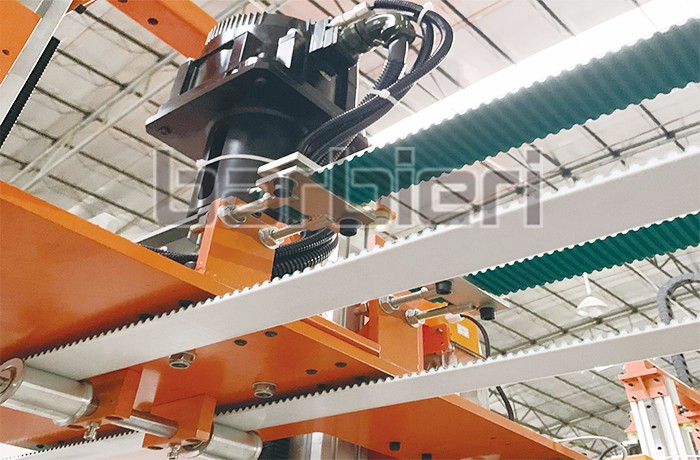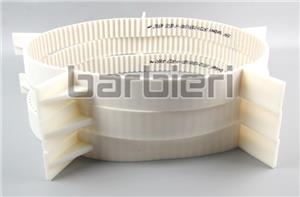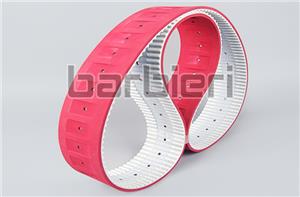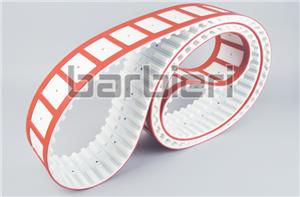Breakthrough in the life of the timing belt

Timing belt service life
Any one of the following three factors will affect the service life of the synchronous belt:
● Poor maintenance (especially in dusty conditions).
● The error in the original design of the equipment, especially the design error at the loading point, caused the material to hit the timing belt quickly, or caused the timing belt to shift due to irregular loading.
● The strength of the timing belt cannot meet the requirements of use (this is related to the special use requirements, especially related to the material of the timing belt).
From the manufacturer's point of view, they can only exert an influence on the last factor to ensure that the product meets the requirements for use.
Improve the system
The huge economic losses made it extremely urgent to find a way to minimize the damage. Although in some old-fashioned equipment, especially the steel core synchronous belt, the tensile strength of the synchronous belt is still improved to extend the service life, but this approach does not actually play a big role. A more effective technical solution to this problem has now been discovered. Some timing belt manufacturers have invested in various detection systems. Although these detection systems are based on different physical principles, the basic principle of placing them is the same, that is, the coil is placed at a fixed angle in the timing belt as an antenna, and a matching sensor is installed on the device to detect whether the coil passes. If one coil is missing, it means that the timing belt is damaged. The electronic control system will automatically stop the operation of the entire equipment. The faster the stopping speed, the less damage the timing belt will be. However, this method is not perfect. If it happens that the coil next to the sensor is broken, the problem will come.
To avoid this, a large mining company cooperated with SIG SpA to test a newly developed protection system. In this system, a Z-shaped conductor is placed along the conveyor belt in the main body of the synchronous belt to form a toroidal coil. Any point on the coil will be damaged and the entire line will be interrupted. So as long as a sensor is placed in the most suitable place of the equipment, it is easy to detect the damaged part of the synchronous belt.
It seems that this is an ideal way to solve the problem, but from the field experience, it also has its shortcomings: the coil is damaged due to mechanical pressure, and the sensor will mistakenly think that there is a problem with the synchronization belt and send an alarm, thereby stopping the operation. .
Because a large number of antenna damages will inevitably cause inevitable losses economically, it is thought that another simple method can be used to replace the use of antennas, which is to simply not use the protection system. In the end, people will question: additional investment in the timing belt to install antennas, electronic equipment and sensors to form an advanced technical system, and after some antennas are damaged, the entire system is useless. Is it worth it?
Self-protection
Based on past experience, SIG SpA tried to look at this problem from a different perspective, and thus put forward the concept of self-protection timing belt: a timing belt that can resist material damage without the use of additional equipment. In other words, by strengthening the heart, the timing belt can be effectively strengthened, so that it is not damaged by external factors (these external factors may penetrate it and cause it to be destroyed). The biggest advantage of this system is that it will not affect the mechanical performance of the timing belt, and it can replace the original timing belt without improving the original equipment.
Lateral deflection
The lateral deflection design reduces the elongation of the timing belt and is specially used for long-distance transportation. The original rubber timing belt with only the longitudinal steel cable has weak anti-destructive ability. After installing the horizontal steel cable (not used to limit the lateral flexibility of the synchronous belt and improve the anti-penetration ability), it has been greatly strengthened, and the sharpness has also been greatly reduced. The probability of the material splitting the timing belt. In addition, after the timing belt is penetrated by a sharp object, the required electric power will be increased, which is enough to activate the electronic protection system, and the length of the timing belt damaged will be limited to only a few meters.
So far, SIG SpA has manufactured and installed more than 800,000 meters of lateral deflection timing belts in departments such as cement plants, steel plants, power stations, mines and ports. Recently, the company has installed 170,000 kilometers of lateral deflection timing belts for coal transportation in many Turkish power stations in its own mines. Turkish customers were deeply moved by its excellent performance and designated them in the equipment to be used in the future. , It is necessary to use lateral deflection timing belts or similar products with transverse steel cable reinforcement. This is a very illustrative example.
Lateral deflection timing belts have also been successfully applied to short-range load-bearing equipment. Large pieces of material fall directly from a high place and hit the timing belt violently. This kind of impact will become particularly dangerous due to the low-speed operation of the equipment. The most representative example is the 10-meter-long lateral deflection timing belt installed in a limestone quarry in northern Italy. Due to a mistake in the initial design, the stones passing through the coarse crusher fell directly on the timing belt from a height of one meter, and carrying and transporting such a heavy and large stone made the timing belt ineffective in a short time. Installing a special impact roller under the timing belt can only last for about one month on average. It seems that this method cannot solve the problem. A stone heavier than the designed weight is enough to damage the new timing belt. Since the only alternative solution was to rebuild the factory, it was decided to install a lateral deflection timing belt. This kind of timing belt has a service life of more than one year, and its durability is ten times that of ordinary fiber timing belts.
Anti-shear timing belt
The success of the lateral deflection timing belt made SIG SpA decided to design a new fiber timing belt, which can be comparable to the lateral deflection timing belt in destructive resistance, while retaining the fiber timing belt. Superiority, such as:
● Light
● Easy to install and connect
● High flexibility
● Inexpensive
● Large reserves
The internal structure of the anti-shear timing belt is similar to the standard composite epoxy timing belt, except that a horizontal steel cable is added to the uppermost rubber timing belt layer to protect the fragile timing belt body through its hindrance. . It is precisely because of the elasticity of these transverse steel cables that the anti-shear timing belt has the same high flexibility as the traditional fiber timing belt; that is to say, the anti-shear timing belt looks like a traditional epoxy timing belt, but has A stronger steel core different from traditional timing belts.
The data in the figure shows the difference in shear resistance and tensile strength between anti-shear timing belts and standard fiber timing belts. The peak corresponds to the wire rope breaking there. For special load-bearing requirements, the energy required to break the timing belt can be increased by increasing the number of steel cables and reducing the peak distance. Mainly used in the treatment of metal and glass scraping and concrete debris. The anti-shear timing belt can be used in any situation where a sharp object may damage the timing belt. This system can also be used in automatic machinery. Because of the requirement to use small wheel diameters and lightweight timing belts, lateral flexing timing belts cannot be used.
Safeguard
Magnetic separator
Improving product quality (such as using low-wear rubber timing belts) is to extend the service life of timing belts, but any of the three influencing factors mentioned above will make the investment in improving product quality more than worthwhile. With the installation and use of the first onshore steel core timing belts, this type of problem has become increasingly prominent. The high cost does not bring high performance of cutting resistance and impact resistance. Therefore, it is necessary to develop a system that can prevent accidents. Installing a magnetic separator at the loading point seems to be a solution. However, it turns out that this only partially solves the problem: For example, during routine maintenance, metal tools are forgotten or accidentally dropped on the timing belt, and they will pierce the timing belt like a razor.




